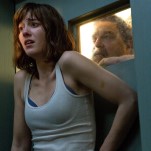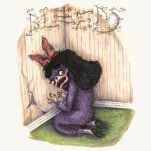The Blurry Lines of Cartel Land
Matthew Heineman examines the ugly realities of drugs on either side of the U.S./Mexican border
Depending on how you look at him, Matthew Heineman is either brave to a T or a madcap with a death wish. The very notion of willfully exposing oneself to the routinely barbaric activities of Mexican drug cartels, both south of and along the U.S./Mexico border, sounds completely ludicrous: Most Americans are lucky enough to live far beyond the reach of that conflict (though as films like 2013’s Narco Cultura suggest, maybe we’re not quite as removed as we like to think). Why would anybody break the distance separating them from the atrocities of cartel violence?
Because caught in the cartel wars’ fracas, there are deeply complex, achingly human stories that need to be told, and someone’s gotta tell them. Heineman’s film, Cartel Land, documents the ugly realities of how the cartels operate from a nation-spanning lens: He devotes his attentions to two separate vigilante groups combating the cartels both at home, where army veteran Tim “Nailer” Foley’s Arizona Border Recon group patrols the region’s mountains for cartel scouts, and in the Mexican state of Michoacán, where the self-defense organization Grupos de Autodefensas, headed by José Manuel Mireles, lead a homegrown campaign against cartels.
Sounds like the plot summary to a Hollywood crime drama, but Heineman’s film is the real deal, shaded with nuances that color Cartel Land with brush strokes of gray. We got the chance to chat with Heineman recently about the risks he took to make his movie, the complexities of his subjects, and the impact vigilante efforts can make on cartel operations.
Paste: So, I’m in a bit of a state of shock just having watched the movie today…
Matthew Heineman: [laughs] Oh yeah?
Paste: I’m so curious—what compelled you to embed yourself on both sides of the conflict the way you did here? That, to me, is just kind of mind-blowing, that you’d put yourself in that kind of situation willingly.
Heineman: Yeah, so I actually read a Rolling Stone article about the Arizona side of the conflict. The minute I read it, I was just fascinated by this world that I knew nothing about. I knew very little about the border, the drug war, about vigilantism, and it just fascinated me. So I spent several months gaining access to [Tim “Nailer” Foley] and his guys, and then filmed there for several months as well. Then, my father actually sent me an article about the Autodefensas in Michoacán, and I right then I knew I wanted to create this sort of parallel narrative of vigilantes on both sides of the border, fighting “the same common enemy,” and then set about gaining access to that side of the story.
I think for me, one of the things that really drove me in making this film was trying to understand, “What would I do if violence came knocking on my front door? What would I do if my sister was raped, and my brother was hanging from a bridge?” Would I take up arms? Would I fight violence with violence? Is that just, is it right, is vigilantism sustainable? These are all questions that drove me to really make this film.
Paste: I definitely identify with that question. We’re asked it point blank by [Dr. José Mireles]. I think the other big question for me in the film is, “Who do you trust?”—particularly toward the end, with the fracturing of the Autodefensas, between Mireles, Papa Smurf, and other people. Was that something that also cropped up in your mind, or did it wind up seeping into the film organically?
Heineman: First of all, that was one of the scariest parts about making this film, that you truly didn’t know if you were with the good guys or the bad guys. You know, originally, I started making this thinking that I was telling this very simple hero/villain story of guys in white shirts fighting guys in black hats, and very quickly I realized that the story was much more complex, much more nuanced, and that there’s a much blurrier line between good and evil. That complexity is what really fascinated me. That’s what drove me. I really almost became obsessed by this story, and trying to find out what was really happening, who these guys really were. But I had absolutely no idea where the story was going when I started, and it was only over time that the film evolved, or devolved, depending on how you’re looking at it.
Paste: Do you think we can believe in complicated heroes? I mean, the Doctor seems sort of like the epitome of “good guy” when we first meet, and then we learn he’s more complicated than that as the film goes on. Then there are the complications of Nailer as well. Is it possible for us to put our trust into these kinds of people or at least find them compelling?
Heineman: Of course! You know, to me, that’s exactly the type of film that I wanted to make. I didn’t want to create a sort of whitewashed portrait of these men. I mean, on a film level, this is a film about the conflict between idealism and violence, and what sort of drives men and women to take up arms, and the motivations that we all have. Since in many ways the film is a character portrait of these two men, the leader of these two groups, I really wanted to show the complexity of who they are, the complexity of their motivations, the complexity of their characters. That’s what fascinated me. I think a lot of narrative films and TV shows are able to create these complex characters, but often in docs you find a much more simplified take on somebody, and I really wanted to avoid that with this film.
Paste: I think the film captures just how complex they both are very well. You said you started off shooting in Arizona, correct?
Heineman: Mmhmm!
Paste: Did you ever think, once you’d started shooting in Mexico, of maybe tuning your focus down to just one of them? Did you ever feel like you maybe would be better serving the movie by making it about Nailer, or making it about the Doctor?
Heineman: I always knew I wanted to create this parallel narrative, this parallel story, and really this character-driven story about these two men. At its heart, it’s about Nailer and the Doctor: They’re both 55 years old, they both believe that the government has failed them, they both have taken “the law into their own hands,” in the effort to fight against evil. And although those are all the similarities, there are stark differences in the two stories. In Mexico, the violence is visceral. The violence [is] real. I mean, 80 thousand plus people killed since 2007, 20 thousand plus people disappeared. The violence and the corruption is unimaginable, whereas in Arizona obviously we’re not seeing that level of violence. It’s much more theoretical. It’s much more of a fear that this violence will seep across our border.
But you do feel in both places that you are in a lawless area that’s controlled by the cartels. Even in Arizona, there is a sense that you’re very far from government institutions, and you really are in “cartel land.” You look on the mountaintops and there are cartel scouts watching you. They’re shepherding drugs, pushing drugs through the valley. You can hear them talking about you as you drive below them. So even there, you feel like you’re in an area that’s controlled by the cartels.
-

-

-

-

-

-

-

-

-

-

-

-

-

-

-

-

-

-

-

-

-

-

-

-

-

-

-

-

-

-

-

-

-

-

-

-

-

-

-

-








































